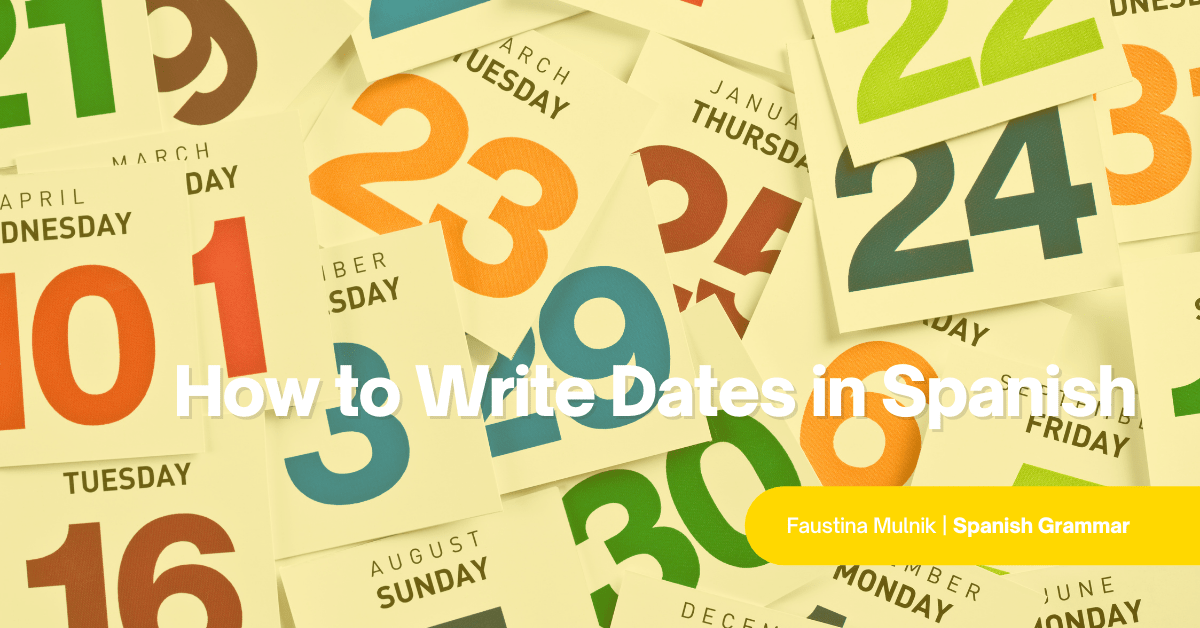
How to Use the ‘Personal A’ in Spanish: Do’s and Don’ts
When learning a new language, sometimes we expect everything to directly translate into our native language. But languages are complex constructions that don’t always work like that. This is the case with the “personal A” in Spanish. It has no translation in English. It’s something that exists and makes sense in Spanish but not in your native language. Think of it as an...Read More
Hacer Conjugation: Free Spanish Lesson, Exercises, and PDF
Some people say that the key to learning Spanish is to master its verb conjugations, and they might not be wrong. Knowing how to properly conjugate verbs in Spanish is a big milestone in the learning process of every student of the language. However, there is no shortcut to achieving this goal. The only way to master the different sets of conjugations of Spanish verbs is by studying...Read More
How To Write Dates in Spanish
Mark your calendar: today’s the day you’ll learn how to write dates, or las fechas, in Spanish! You may want to write an email, book your next holiday to a Spanish-speaking destination, or schedule an event. Learn how to write dates in Spanish so you can enjoy planning holidays, events, and days out while also making sure that you’ll be there at the right time. Once you understand the...Read More
‘Tener’ Subjunctive Mood: How To Use It the Right Way
The subjunctive forms of the Spanish verb tener may look hard at first, but they are actually quite easy. We are going to show you why! Luckily, you don’t need to memorize all of these conjugations—instead, focus on understand their usage to be able to apply the verb to all sorts of new scenarios. Keep reading to learn more about the Spanish verb tener, its many meanings, and how...Read More
Ser Conjugation: Free Spanish Lesson, Quiz, Exercises, and PDF
To be, or not to be? That is the question… Or is it? The real question is: Which “to be” verb do I use in Spanish and how do I conjugate it correctly? As you likely already know, two different verbs exist in Spanish that mean “to be,” and each has a very precise meaning. In this blog post, we explore in depth the Spanish verb ser and its conjugation. (Want to...Read More
Hallar vs Encontrar: What’s the Difference?
If you’ve been studying Spanish for some time already, you’ve surely encountered the hallar vs encontrar dilemma. They both seem to mean “to find,” but can they really be used interchangeably? Linguists say that absolute synonyms don’t exist, and there will always be differences in how you use these words in terms of register or emotional value. Their use may also vary depending on the...Read More
Meter vs Poner in Spanish: What’s the Difference?
Meter vs poner is one combination that gives beginner Spanish learners lots of headaches! Not only do both translate into “put,” but they are also kind of catch-all words with tens of uses. Will you believe me if I tell you that it’s not that difficult to understand the difference between these two words? You should! Just keep reading, and I will explain when and how to use these two...Read More
Introducir vs Presentar in Spanish: What’s the Difference?
Introducir vs presentar are confusing verbs, even for fully bilingual people! These Spanish words are false cognates, and—trust me—confusing them leads to awkward looks from others. Let’s have a thorough look at introducir vs presentar. We’ll cover in detail the definitions, conjugations, and sample sentences. Join more than 559 people on the planet who speak Spanish!Sign up for your...Read More
Apoyar vs Soportar in Spanish (Plus Aguantar and Mantener)
Apoyar vs soportar is confusing at times when they both seem to mean “to support.” For example: Mis padres me apoyan.My parents support me. Las vigas soportan la construcción temporal. The beams support the temporary construction. Why do these two Spanish verbs translate into the same English word? Are they interchangeable? (Spoiler alert: they aren’t!) How...Read More
